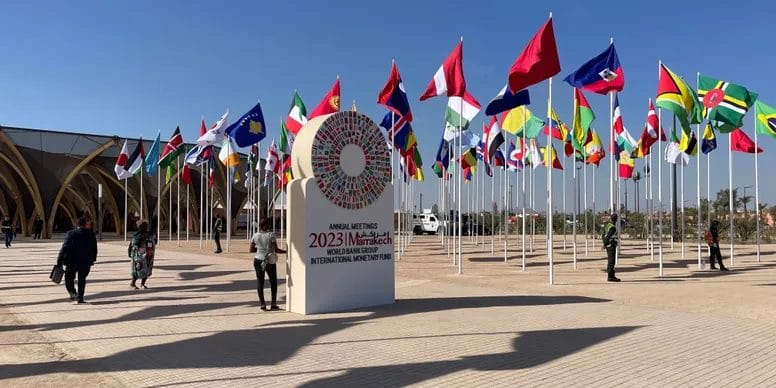
Last week, the annual meetings of the International Monetary Fund (IMF) and the World Bank took place in Marrakech, Morocco. The mood of the meeting was sober to begin with, as the meetings took place just over a month after the country was shaken by a devastating earthquake less than 100 km away from Marrakech. Additionally, during the weekend before the meetings began, the news broke of the attack by Hamas to Israel, which left thousands of people dead, and many wounded or captured as hostages.
It is within this very sombre environment that the IMF released its latest forecasts, which did not bring much better news. The latest estimates of the IMF’s World Economic Outlook show a downward revision to the 2024 growth forecast, from 3.0% previously down to 2.9%, marking a further deceleration from the 3.0% that had been expected in 2023, and well below the 3.8% average of the last few years pre-pandemic. The projection would have been even worse if it wasn’t for an upward revision to the US growth forecasts for 2023 and 2024 (by 0.3% to 2.1% and by 0.5% to 1.5%, respectively). The projections for other key countries and regions such as China and the Eurozone were revised lower, however. This is why the IMF says that the “resilient global economy is limping along, with growing divergences.”
Inflation is expected to remain well above the targets of central banks; for example at4.1% and 2.8% in 2023 and 2024 in the US, at 5.6% and 3.3% respectively in the Eurozone, and 5.0% and 2.9% in other advanced economies. The IMF says that “global inflation is forecast to decline steadily, from 8.7 percent in 2022 to 6.9 percent in 2023 and 5.8 percent in 2024, due to tighter monetary policy aided by lower international commodity prices. Core inflation is generally projected to decline more gradually, and inflation is not expected to return to target until 2025 in most cases.” So, a sort of stagflationary scenario of weakening growth, coupled with persistent inflation, continues to characterize large segments of the global economy.
What can policy do to address this? The IMF says that “monetary policy actions and frameworks are key at the current juncture to keep inflation expectations anchored […] Chapter 2…emphasizes the complementary role of monetary policy frameworks, including communication strategies, in helping achieve disinflation at a lower cost to output through managing agents’ inflation expectations.” All this has been translated by the world’s major central banks with the formula “higher for longer,” referring to policy rates being set at higher levels, for longer than the market expects.
But the question has emerged as to whether central banks should actually raise their policy rates further, given the ongoing slowdown in economic activity and the increased uncertainty due to the recent terrorist attacks in Israel, which are leading the country to conduct a land campaign in the Gaza Strip. If central banks were to come to the conclusion that rates won’t need to be raised further, then the formula should be changed to “high for longer” than the market expects. But since, when economists meet, all possibilities must be explored, two additional combinations can be considered. One would be “higher for long”, implying that central banks would be prepared to continue increasing rates for a prolonged period of time. The other would be “high for long,” in which case rates would be kept at current levels for a protracted period of time.
The policy meetings of the Federal Reserve, Bank of England and the European Central Bank that will take place in coming weeks will tell which of these four combinations will be chosen by each central bank.